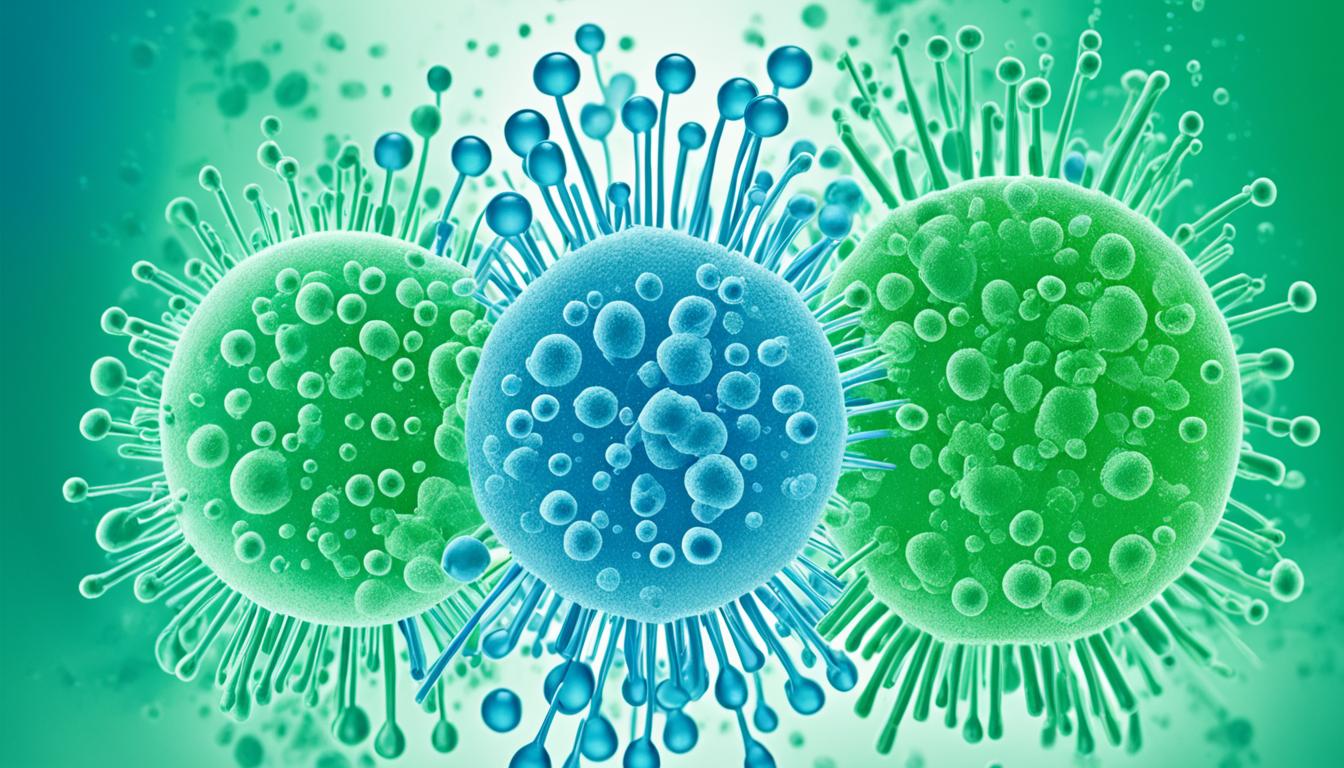Legionnaires’ disease is a serious form of pneumonia caused by Legionella bacteria. The sickness brings on tough respiratory symptoms, like an unending cough, high fever, and troubles in breathing. These bacteria lurk in water sources, such as hot tubs and plumbing systems, underlining the need to spot the disease early.
To figure out if someone has Legionnaires’, doctors usually run urine tests and culture samples to find Legionella bacteria. The earlier they find it, the better the chance of quick and helpful treatment. This process is really important.
Modern times have seen big progress in using stem cell therapy to treat Legionnaires’. This therapy hopes to heal and renew lung tissue. By doing this, it may get breathing back to normal and make the patient feel better overall. It’s a new and promising way to help patients have a better quality of life.
Key Takeaways:
- Legionnaires’ disease is a severe form of pneumonia caused by Legionella bacteria.
- Common symptoms include cough, fever, and shortness of breath.
- Legionella bacteria are found in water sources such as hot tubs and cooling towers.
- Diagnosis involves urine antigen testing and culture.
- Advancements in stem cell therapy offer potential benefits for treating Legionnaires’ disease.
Legionnaires’ Disease Risk Factors and Prevention
It’s important to know what increases the chance of getting Legionnaires’ disease. Factors like being older, smoking, and having a weak immune system raise your risk. Also, if you work with water that may have Legionella bacteria, like in healthcare or construction, you’re more likely to get sick.
Working in places with lots of water can be riskier. This is because the bacteria that cause Legionnaires’ disease like to grow in water. But remember, anyone can get this illness.
Preventive steps are key in stopping the spread of Legionella bacteria. This helps reduce the number of Legionnaires’ disease cases. Key actions to prevent this disease include:
- Keeping water systems clean and maintained well
- Using the right cleaning methods for hot tubs and cooling towers
- Having good air circulation in buildings
By following these steps, we can lower the bacteria’s chance of growing. This makes it less likely for people to get sick.
Prevention Guidelines and Regulations
To stop people from getting Legionnaires’ disease, certain rules and best practices must be followed. These can change depending on the country or area. But they often include the following:
| Preventive Measure | Description |
|---|---|
| Regular water system maintenance | Inspecting, cleaning, and disinfecting water systems often to get rid of Legionella bacteria. |
| Proper hot tub maintenance | Keeping hot tubs clean and using enough chlorine to prevent bacteria growth. |
| Effective cooling tower management | Cleaning and disinfecting cooling towers frequently to stop the spread of Legionella bacteria. |
| Building design and ventilation | Making sure buildings are well-ventilated to avoid water buildup and encourage good air flow. |
By sticking to these rules, we can keep Legionnaires’ disease away. This keeps people safe from getting sick.
Legionnaires’ Disease Treatment and Management
Quick and the right treatment is key in managing Legionnaires’ disease well. Doctors use specific antibiotics like fluoroquinolones or macrolides. The type chosen depends on how severe the illness is and your health. The antibiotics kill the Legionella bacteria, lessening symptoms and stopping further problems.
Along with antibiotics, supportive care matters a lot in treating Legionnaires’ disease. Patients might get oxygen to help them breathe better. They should also drink plenty of fluids. This keeps them from getting dehydrated and supports their overall health. Staying hydrated is crucial for symptom management and recovery.
Keeping a close eye on a patient and following up are also crucial parts of care. They help doctors check if the treatment is working well and spot any new health issues. With regular visits and assessments, the doctor can see how the patient is doing. This helps catch problems or check for any signs of the illness coming back.
People diagnosed with Legionnaires’ disease must follow their treatment plan strictly. This includes taking medicines as directed and going to all doctor’s appointments. It’s also important to report any changes in how you’re feeling. These steps are key to managing the illness well and getting the best outcome.
Treatment and Management Table:
| Treatment Approach | Details |
|---|---|
| Antibiotics | Fluoroquinolones or macrolides are commonly prescribed to eliminate the Legionella bacteria and reduce symptoms |
| Supportive Care | Oxygen therapy and fluids to manage symptoms and support overall respiratory health |
| Close Monitoring | Regular follow-up evaluations and check-ups to assess treatment effectiveness and address any ongoing health issues |
Getting the right treatment on time is crucial for Legionnaires’ disease. This approach, using antibiotics, care, and close monitoring, is vital for a good recovery. It decreases the chance of severe health issues related to this lung infection.
Conclusion
Legionnaires’ disease is a severe illness caused by Legionella bacteria. It’s vital to know the symptoms and risk factors to reduce its spread. Getting diagnosed early and treated promptly with the right medicine is key.
Stem cell therapy has shown promise in treating Legionnaires’ disease. It could lead to better outcomes and even a cure. This therapy works to repair lungs affected by the disease, improving breathing and health.
Knowing about Legionnaires’ disease and taking steps to prevent it helps everyone. This includes individuals and healthcare workers. Keeping water sources clean and following safety rules is important. This prevents outbreaks and lowers the chance of getting sick. With quick action and the hope of stem cell therapy, we’re fighting against this disease to make life better for those hit by it.

